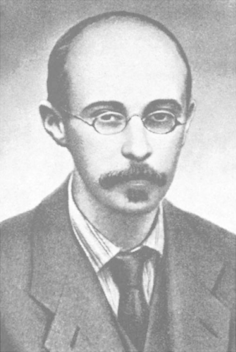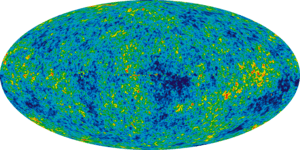Alexander Friedmann
Alexander Alexandrovich Friedmann (also spelled Friedman or Fridman /ˈfriːdmən/; Russian: Алекса́ндр Алекса́ндрович Фри́дман) (June 16 [O.S. 4], 1888 – September 16, 1925) was a Russian and Soviet physicist and mathematician. He is best known for his pioneering theory that the universe was expanding, governed by a set of equations he developed now known as the Friedmann equations.
Alexander Friedmann | |
|---|---|
 Alexander Friedmann | |
| Born | Alexander Alexandrovich Friedmann June 16, 1888 |
| Died | September 16, 1925 (aged 37) Leningrad, USSR |
| Nationality | Russian |
| Alma mater | St. Petersburg State University |
| Known for | |
| Spouse(s) | Natalia Malinina |
| Scientific career | |
| Fields | Mathematics and physics |
| Institutions | Petrograd Polytechnical Institute Main Geophysical Observatory |
| Doctoral advisor | Vladimir Steklov |
| Doctoral students | |
| Signature | |
| Part of a series on | ||||
| Physical cosmology | ||||
|---|---|---|---|---|
 | ||||
|
Early universe
|
||||
|
Expansion · Future |
||||
|
Components · Structure
|
||||
| ||||
Early life
Alexander Friedmann was born to the composer and ballet dancer Alexander Friedmann (who was a son of a baptized Jewish cantonist) and the pianist Ludmila Ignatievna Voyachek.[1] Friedmann was baptized into the Russian Orthodox Church as an infant, and lived much of his life in Saint Petersburg.
Friedmann obtained his degree from St. Petersburg State University in 1910, and became a lecturer at Saint Petersburg Mining Institute.
From his school days, Friedmann found an inseparable companion in Jacob Tamarkin, who at the end of his career was one of Brown University's most distinguished mathematicians.[2]
World War I
Friedmann fought in World War I on behalf of Imperial Russia, as an army aviator, an instructor and eventually, under the revolutionary regime, as the head of an airplane factory.[3]
Professorship
Friedmann in 1922 introduced the idea of an expanding universe that contained moving matter. Correspondence with Einstein suggests that Einstein was unwilling to accept the idea of an evolving Universe and worked instead to modify his equations to ensure a static eternal Universe as believed from Newton's time. Some years later, in 1926 Hubble published the redshift vs distance relationship, namely, all the galaxies in the neighborhood seemed to be receding at a rate proportional to their distance, formalising an observation made earlier by Carl Wilhelm Wirtz. It may be noted that in 1927 Belgian astronomer Georges Lemaître also independently reached the conclusion of an evolving Universe.[4]
In June 1925 Friedmann was given the job of the director of Main Geophysical Observatory in Leningrad. In July 1925 he participated in a record-setting balloon flight, reaching the elevation of 7,400 m (24,300 ft).[5]
Work
Relativity
Friedmann's 1924 papers, including "Über die Möglichkeit einer Welt mit konstanter negativer Krümmung des Raumes" ("On the possibility of a world with constant negative curvature of space") published by the German physics journal Zeitschrift für Physik (Vol. 21, pp. 326–332), demonstrated that he had command of all three Friedmann models describing positive, zero and negative curvature respectively, a decade before Robertson and Walker published their analysis.
This dynamic cosmological model of general relativity would come to form the standard for both the Big Bang and Steady State theories. Friedmann's work supports both theories equally, so it was not until the detection of the cosmic microwave background radiation that the Steady State theory was abandoned in favor of the current favorite Big Bang paradigm.
The classic solution of the Einstein field equations that describes a homogeneous and isotropic universe is called the Friedmann–Lemaître–Robertson–Walker metric, or FLRW, after Friedmann, Georges Lemaître, Howard P. Robertson and Arthur Geoffrey Walker, who worked on the problem in 1920s and 30s independently of Friedmann.
Hydrodynamics and meteorology
In addition to general relativity, Friedmann's interests included hydrodynamics and meteorology.
Students
Physicists George Gamow, Vladimir Fock and Lev Vasilievich Keller[5] were among his students.
Personal life
In 1911, he married Ekaterina Dorofeeva, though he later divorced her. He married Natalia Malinina in 1923. They had a religious wedding ceremony, though both were far from religious.[6]
Death
Friedmann died on September 16, 1925 from misdiagnosed typhoid fever. He had allegedly contracted the bacteria on his way back from his honeymoon in Crimea when he ate an unwashed pear he bought from a railway station.[7]
Named after Friedmann
The moon crater Fridman is named after him.
Alexander Friedmann International Seminar
Alexander Friedmann International Seminar is a periodical scientific event. The objective of the meeting is to promote contacts between scientists working in the field of Relativity, Gravitation and Cosmology and related fields. The First Alexander Friedmann International Seminar on Gravitation and Cosmology devoted to the centenary of his birth took place in 1988.
Selected publications
- Friedman, A. (1922). "Über die Krümmung des Raumes". Zeitschrift für Physik. 10 (1): 377–386. Bibcode:1922ZPhy...10..377F. doi:10.1007/BF01332580.. English translation in: Friedman, A. (1999). "On the curvature of space". General Relativity and Gravitation. 31 (12): 1991–2000. Bibcode:1999GReGr..31.1991F. doi:10.1023/A:1026751225741. The original Russian manuscript of this paper is preserved in the Ehrenfest archive, together with some letters and unpublished work.
- Friedman, A. (1924). "Über die Möglichkeit einer Welt mit konstanter negativer Krümmung des Raumes". Zeitschrift für Physik. 21 (1): 326–332. Bibcode:1924ZPhy...21..326F. doi:10.1007/BF01328280.. English translation in: Friedmann, A. (1999). "On the Possibility of a World with Constant Negative Curvature of Space". General Relativity and Gravitation. 31 (12): 2001–2008. Bibcode:1999GReGr..31.2001F. doi:10.1023/A:1026755309811.
References
- Hockey, Thomas (2009). The Biographical Encyclopedia of Astronomers. Springer Publishing. ISBN 978-0-387-31022-0. Retrieved August 22, 2012.
- Pyenson L. Book review. Physics Today [serial online]. September 1994; 47(9):93. Available from: MasterFILE Premier, Ipswich, MA. Accessed October 18, 2012.
- Pyenson L. Book review. Physics Today [serial online]. September 1994;47(9):93. Available from: MasterFILE Premier, Ipswich, MA. Accessed October 18, 2012.
- Daintith J. Dictionary Of Scientists [e-book]. Oxford University Press; 1999. Available from: eBook Collection (EBSCOhost), Ipswich, MA. Accessed October 18, 2012.
- Davidson et al., A Voyage Through Turbulence, Cambridge University Press, ISBN 9780521149310, September 2011 (for a partial and legal excerpt of the book, see: )
- Eduard A. Tropp; Viktor Ya. Frenkel; Artur D. Chernin (2006). "The final year". Alexander A Friedmann: The Man who Made the Universe Expand. Cambridge University Press. p. 209. ISBN 9780521025881.
[Alexander Friedmann and Natalia Malinina] even had a religious wedding ceremony in the Crimea, though both were far from religious. “Just to make it stronger,” Friedmann said to his wife (she told this to her sister Sofia).
- Френкель, Виктор Яковлевич (1988-07-01). "Александр Александрович Фридман (Биографический очерк)". Успехи физических наук (in Russian). 155 (7): 481–516. ISSN 0042-1294.
Bibliography
- Poluboyarinova-Kochina, P. Ya. (January–February 1964). "Aleksandr Fridman" (PDF). Soviet Physics Uspekhi (English Edition): 467–472.CS1 maint: ref=harv (link)
- Ferguson, Kitty (1991). Stephen Hawking: Quest For A Theory of Everything. New York: Bantam Books. ISBN 0-553-29895-X.CS1 maint: ref=harv (link)
- Frenkel', V.Ya. (1988). "Aleksandr Aleksandrovich Fridman (Friedmann): a biographical essay". Soviet Physics Uspekhi. 31 (7): 645–665. Bibcode:1988SvPhU..31..645F. doi:10.1070/PU1988v031n07ABEH003574.
External links
- Alexander A Friedmann: The Man who Made the Universe Expand – Biography written by Eduard A. Tropp, Viktor Ya. Frenkel and Artur D. Chernin
- O'Connor, John J.; Robertson, Edmund F., "Alexander Friedmann", MacTutor History of Mathematics archive, University of St Andrews.
- How Do We Know the Age of the Universe – Mary Lynn Germadnik
